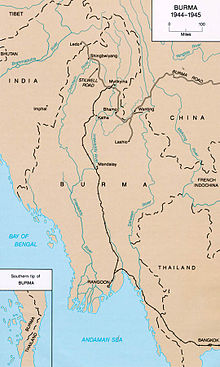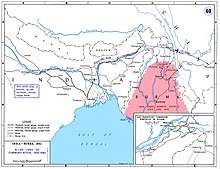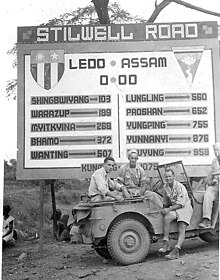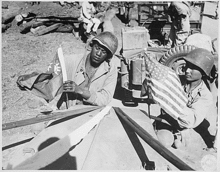
Back ষ্টিলৱেল পথ Assamese Ledo-Straße German Ledo Vojo Esperanto جاده لدو Persian Ledontie Finnish Route de Ledo French લેડો રોડ Gujarati דרך לדו HE लेडो रोड Hindi Jalan Raya Ledo ID
| Ledo Road | |||||||
|---|---|---|---|---|---|---|---|
| Chinese | 中印公路 | ||||||
| Literal meaning | China–India Highway | ||||||
| |||||||
| Alternative Chinese name | |||||||
| Chinese | 史迪威公路 | ||||||
| Literal meaning | Stilwell Highway | ||||||
| |||||||



| Ledo Assam | 0 | ||||||||||||||||||||
|
| ||||||||||||||||||||
| Kunming | 1079 |


The Ledo Road (Burmese: လီဒိုလမ်းမ) was an overland connection between British India and China, built during World War II to enable the Western Allies to deliver supplies to China and aid the war effort against Japan. After the Japanese cut off the Burma Road in 1942 an alternative was required, hence the construction of the Ledo Road. It was renamed the Stilwell Road, after General Joseph Stilwell of the U.S. Army, in early 1945 at the suggestion of Chiang Kai-shek.[3] It passes through the Burmese towns of Shingbwiyang, Myitkyina and Bhamo in Kachin state.[4] Of the 1,726 kilometres (1,072 mi) long road, 1,033 kilometres (642 mi) are in Burma and 632 kilometres (393 mi) in China with the remainder 61 km was in India.[5] The road had the Ledo-Pangsau Pass-Tanai (Danai)-Myitkyina--Bhamo-Mansi-Namhkam-Kunming route.
To move supplies from the railheads to the Army fronts, three all-weather roads were constructed in record time during the autumn (fall) of 1943: Ledo Road in the north across three nations, which went on to connect to the Burma Road and supply China; the campaign-winning Central Front road within India from Dimapur to Imphal; and the southern road from Dohazari south of Chittagong in British India for the advance of troops to Arakan in Myanmar.[6]
In the 19th century, British railway builders had surveyed the Pangsau Pass, which is 1,136 metres (3,727 feet) high on the India-Burma border, on the Patkai crest, above Nampong, Arunachal Pradesh and Ledo, Tinsukia (part of Assam). They concluded that a track could be pushed through to Burma and down the Hukawng Valley. Although the proposal was dropped, the British prospected the Patkai Range for a road from Assam into northern Burma. British engineers had surveyed the route for a road for the first 130 kilometres (80 miles). After the British had been pushed back out of most of Burma by the Japanese, building this road became a priority for the United States. After Rangoon was captured by the Japanese and before the Ledo Road was finished, the majority of supplies to the Chinese had to be delivered via airlift over the eastern end of the Himalayan Mountains known as the Hump.
After the war, the road fell into disuse. In 2010, the BBC reported "much of the road has been swallowed up by jungle."[5]
- ^ Staff. The Stilwell Road Archived 13 October 2008 at the Wayback Machine, District Administration, Tinsukia (Assam) Archived 12 February 2007 at the Wayback Machine, Cites Sri Surendra Baruah, Margherita, Retrieved 1 October 2008
- ^ Weidenburner. Ledo Road Signs Archived 19 May 2007 at the Wayback Machine
- ^ Bernstein, Richard (2014). China 1945 : Mao's revolution and America's fateful choice (First ed.). New York. p. 38. ISBN 9780307595881.
{{cite book}}: CS1 maint: location missing publisher (link) - ^ Bhaumik, Subir (11 August 2009). "India not to reopen key WWII road". BBC News. Archived from the original on 11 August 2009. Retrieved 7 May 2010.
- ^ a b Bhaumik, Subir. "Will the famous Indian WWII Stilwell Road reopen?". BBC News. Archived from the original on 14 August 2015. Retrieved 11 March 2016.
- ^ Slim 1986, p. 171.
© MMXXIII Rich X Search. We shall prevail. All rights reserved. Rich X Search